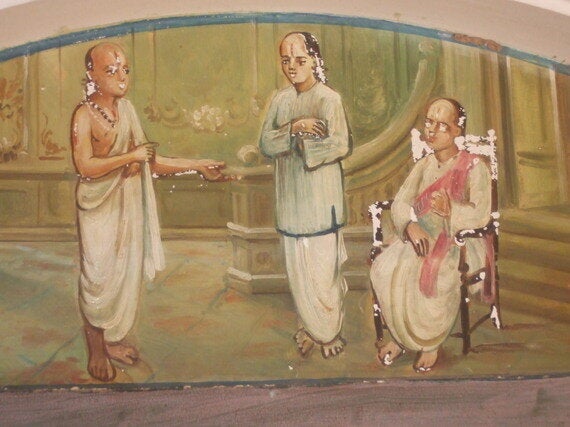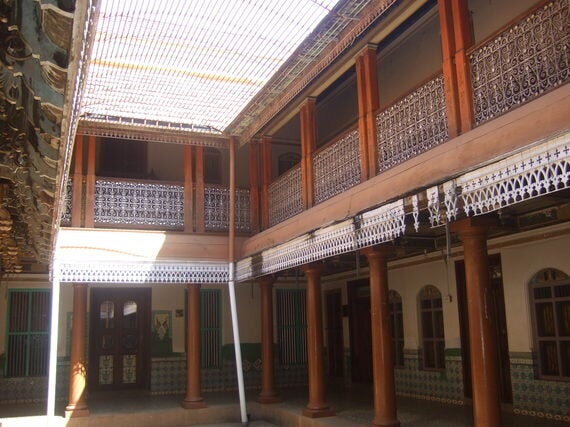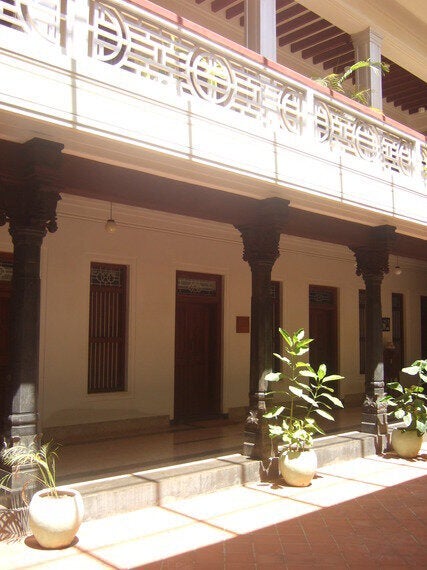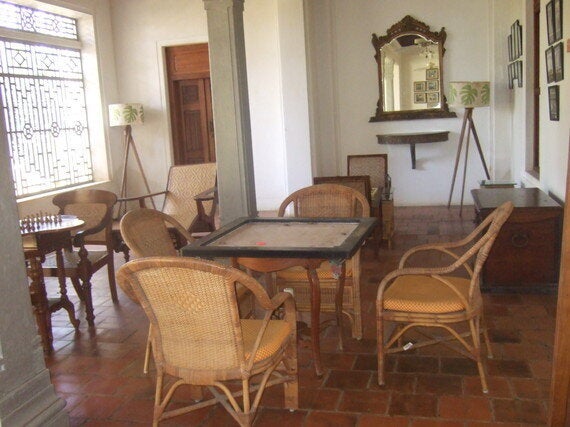
There's a crumpled old lady, taking the late afternoon air on the steps at the entrance to the abandoned mansion. 85 rupees to show us round, she says. That's about £1.50, and, as with the temples we've visited over the last weeks, we must take off our shoes and leave them at the entrance. I reach into my pocket for some low denomination rupee notes. These are so old and used they are more like wet lettuce leaves than bank notes and I wash my hands in alcohol gel after every contact. They are always needed throughout the day at temples, for tips, and for beggars - they are like gold dust. Although they're not worth much in money terms, they are so hard to get hold of, that they have a value way above their specified number.
The old lady turns an enormous key in an old iron lock and limps into the empty house, indicating that we should follow. Inside is a preposterously over- decorated courtyard, decaying in the sunlight, which leads onto another, similar courtyard, and another; tiles from Italy jam up against carved pillars from Belgium, teak panelling from Burma abuts wrought iron work from Birmingham. Every inch is covered in design. There are fading frescoes high up, depicting family members of days gone by. Walls are lined with a limestone and eggshell plaster which keeps the rooms, all 60 of them, miraculously cool. Apart from the crumpled old lady, who is our guide, there is complete and eerie silence. Everything is dilapidated, edges are rounded and rain ingress from many monsoons has dried into a silt across several ceilings.

This is the abandoned mansion of a Chettiyar family, in the village of Kanadukathan near Chettinad, in Tamil Nadu. But it's not the only one, the area is studded - there are one hundred and one similarly abandoned stately houses in this village alone. One or two are in Art Deco style, but most seem to be an eclectic, almost comical mash-up of every possible style known.
In the middle of the 18th century, the rich Chettiyar families moved here after a tsunami wiped out their opulent lifestyles on the coast. Nowadays, the houses have been abandoned as the Indian diaspora has claimed many family members who now work abroad. Upkeep is difficult and expensive, and many of the houses have eight or so different legal owners - cousins, brothers, nieces - who now prefer to live in Cennai, or the USA or Europe. What's odd is that there are so many of these extraordinary houses in such an out of the way place. Unesco are currently considering what to do with them, as they will be falling down with neglect soon. I would recommend paying a visit sooner rather than later.
And the best place to visit them from is itself a former Chettiyar mansion. This one has been converted into an extremely pleasant hotel; The Visalam. Only fifteen rooms, cotton towels, coconut oils and basil soap in the spacious bathroom. I had the most relaxed few days of our entire Tamil Nadu trip here. The swimming pool and restaurant are excellent and the staff are really friendly. Like the other mansions, the Visalam is an extraordinary building; beautifully laid out in the colonial style with old wooden doors, wrought iron shutters, and lovely antique furniture. It is a haven.

You can take a bicycle out from the hotel - early morning recommended to avoid the heat - and explore the area; Chettinad station with its old-school painted wooden time-table signs, the overgrown airfield, used by the British during the war, now overrun with giant peacocks. Or go with Ramu, a member of the hotel staff, to his house, which is yet another of the haunting mansions.

This is the house where he was born. His eighty two year old auntie is resting on the portico. A brother, a cousin and her children also live here, but it would be possible to go for days without encountering them, the place is so big. In the main courtyard a clothes line is strung between too carved teak-wood pillars. Clothes on hangers dangle from this and there are a few photos of family on the wall, above some lonely plastic tubs and buckets. All of this takes up maybe two per cent of the overall courtyard space, and there are several courtyards; the actual living area being a tiny fraction of the building's potential for grandeur.
It's the same in the kitchen - an open air courtyard covered with nets to stop the monkeys getting in. The actual part of the kitchen in use is a small corner of the overall space available. It would cost a fortune to install modern appliances here, and, as a listed piece of heritage, one might find oneself up against all kinds of red tape. So Ramu and his family are virtually camping in a palace.
The dignity of these old mansions is magnificent. Standing there in fading glory, their colours and decorations crumbling. And the sheer quantity of them is overwhelming. A small village, swelling with what must once have been enormous wealth. One of the most bizarre and intriguing places I have been to in India.
